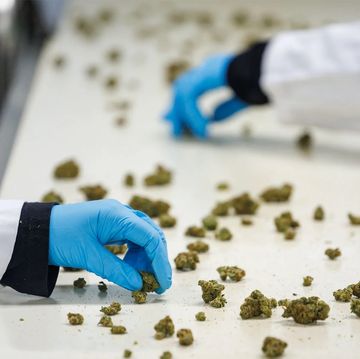From schools of sardines that migrate down the coast to giant sea bass that can measure seven feet, more than 900 species of fish swim the waters off the narrow Baja peninsula. Flanked by the Pacific Ocean and the Sea of Cortez—the latter famously dubbed “the world’s aquarium” by French oceanographer Jacques Cousteau—the states of Baja California and Baja California Sur afford the finest catch in all of Mexico.
It’s no surprise, then, that chefs and street vendors from Tijuana to Cabo San Lucas serve the best seafood in the country, refined from Sinaloan and Sonoran traditions. You’ll find exquisite shellfish such as chocolata clams, pen shell clams (a species known as callo de hacha), and pismo clams shucked and prepared at carts and stands; in restaurants, prized local spiny lobster, sea urchin, and spider crab are often on the menu, along with Mexico’s finest shrimp. The peninsula is known for seven fish in particular, so we’ve put together this guide to help you find the most delicious culinary spin on each one, whether at a food truck, a street cart, or a high-end winery kitchen.
Bluefin tuna at Manzanilla in Ensenada
Since opening its doors in 2000, chefs Benito Molina and Solange Muris’s modern-Mexican restaurant Manzanilla has created a blueprint for Ensenada and Valle de Guadalupe cuisine. When locally farmed bluefin tuna is on the menu, diners can expect dishes like tiradito de atún, an attractive plate of bright red strips of raw fish doused in soy sauce and raspberry vinegar and seasoned with chopped ginger and serrano chile. A special appetizer of oysters topped with bluefin tuna ceviche is another draw, and it pairs perfectly with a crisp white Mexican wine.
Sea urchin tostadas at La Guerrerense in Ensenada
Ensenada’s legendary ceviche cart on the corner of Adolfo López Mateos and Alvarado has long been beloved for its impressive menu of seafood and raw shellfish, but it’s the sea urchin tostadas that have turned the cart into an international culinary destination. The family that runs La Guerrerense has been at it since 1960. Matriarch Sabina Bandera cooks and cools Baja California sea urchin for a ceviche mixed with tomatoes, white onions, garlic, and cilantro, which she spreads over a corn tostada. Then Bandera tops the concoction with pismo clam and avocado slices and dresses it with her salsa of charred chiles, nuts, and seeds. This ceviche de erizo con almeja—or sea urchin ceviche with clam—is reason enough to cross the border for a world-class dining experience on a street corner.
Clams and oysters at Tatanka Baja Fish & Steakhouse in La Paz
Carlos Valdez grew up near waters teeming with the finest shellfish in Mexico. The Sonoran chef always gets his hands on the freshest seafood available. But he’s also known for his creative specials and his eye-catching presentations. Valdez sources cultivated and wild shellfish such as geoduck, patas de mula (blood clams), and caracol burro (conch) and often plates them with Japanese flavors including ginger, soy sauce, and tobiko. He serves the garra de león variety of clams in a sharp Peruvian-style leche de tigre; callo de hacha with lime, salt, and a garnish of serrano chile rings; and chocolata clams with black truffle. Oysters like pai pai, kumiai, kumamoto, gigas, and chingón are hand-selected and served raw or grilled.
Queen clams at Mariscos El Conchal in Tijuana
Across the street from Tijuana’s Mercado Miguel Hidalgo is a trailer wrapped in shades of oceanic blue that’s acclaimed for Sinaloa-style shellfish, cocktails, ceviche, and molcajetes brimming with prized seafood. Locals call the trailer El Paisa, or “countryman,” because that’s what the owner of the stand, Humberto Buelna, calls his customers, just as he would back home in Sinaloa. The staff here prepare beautiful, hefty queen clams worthy of the world’s finest restaurants but available just minutes over the border. They’re overlaid with chopped tomato, purple onion, cucumber, and cilantro, then finished with fresh lime juice and seasonings. Grab a bottle of hot sauce for a little fire on top.
Abalone at Fauna in Valle de Guadalupe
The most exciting restaurant in Valle de Guadalupe is David Castro Hussong’s six-year-old Fauna, nestled within the boutique hotel and winery Bruma; here, the chef features pristine shellfish and farm-to-table ingredients cooked over a wood fire. The abalone aguachile, a regular menu item, is a standout: tender strips of locally cultivated abalone are served inside its brick-red shell with pumpkin seeds and a mixture of fresh lime and green chile purée; it’s subtly sweet with a light brine. A frequent special of the coveted shellfish comes topped with grilled asparagus and a fried quail egg. Paired with Bruma’s wines, it’ll kick-start a guaranteed memorable meal.
Spider crabs at Mariscos La Estrella in Popotla
For years, Popotla was a sleepy fishing village where locals purchased seafood from commercial anglers and indulged in such delicacies as sea urchin, abalone, lobster, and spider crab—the latter playfully referred to as marcianos, or “martians,” for their red, extraterrestrial features. Lorena López’s beachside restaurant, Mariscos La Estrella, has spurred the growth of the culinary scene, and that’s mostly due to her take on those martians: she fries them whole, including knobby joints, long legs, and huge claws packed with sweet meat, then bathes them in garlic butter or a la diabla, a spicy sauce that’s spooned over the entire crustacean. Customers are handed heavy stones for cracking open the formidable exoskeleton to pull out the meat and eat it with flour tortillas. Just make sure to hold on to your michelada cocktail when you’re breaking the crab down, or it’ll be launched off the plastic table from the force of the stone.
Lobster at La Casa de La Langosta in Puerto Nuevo
From Mexican Independence Day, on September 16, through mid-February, spiny lobsters are an attraction in Puerto Nuevo, Baja California’s world-famous lobster village just south of Rosarito. Since 1985, patrons have visited La Casa de La Langosta, a charming spot lined with faux-brick wall panels, for Puerto Nuevo–style lobster, a recipe created by Señora Susana Díaz López de Plascencia in 1956. A plate of whole lobster fried in lard comes with creamy refried beans, Mexican rice, flour tortillas, and clarified butter. Another Puerto Nuevo classic is a lobster burrito: the fried lobster, moistened with some mayonnaise, plus chopped tomatoes, onions, and salsa are all wrapped in a flour tortilla.•
Bill Esparza is a James Beard Award–winning food writer, a leading authority on Latin American cuisines, and the author of the book LA Mexicano.














